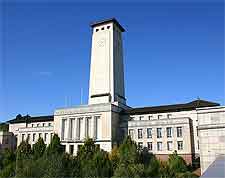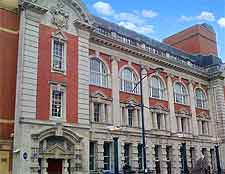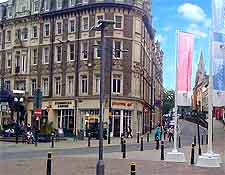Newport History Facts and Timeline
(Newport, Gwent, South Wales, UK)

Newport's history appears to have begun in the 7th century AD, when St. Woolos Church was founded on the top of Stow Hill. It's interesting to note that the word Stow can be translated from the Old English as 'holy place'.
There are several references in the records to Newport's early origins. These include a raid that was made by Harold Godwinson in 1063. Harold went on to lay waste to the area, including making an attack on St. Woolos Church.
History from the Middle Ages
At some point during the late 11th century, Robert de la Hay, a Norman lord who controlled land in this region, granted St. Woolos Church to Gloucester Abbey. The Normans brought many other changes to the village they called Novo Burgus. They built a stone castle, Castell Newydd, from which they administered the lordship. A town grew up around it and in 1198, Newport passed into the hands of Prince John.
Newport received its first charter in 1314. Throughout the 14th century, the town seems to have been frequently involved in unrest and land disputes. At any rate, the lordship of Newport changed hands at a rapid rate. Otherwise, relatively little is known about medieval Newport or its importance as a centre for sea trade. We do know, however, that by 1521, many small merchant ships were at anchor in its harbour and there were numerous trades being carried out here, including leather tanning, and starch and soap making.

The Coming of the Industrial Revolution
In the mid-18th century, new life was breathed into Newport. Within a relatively short space of time it changed from a small-time port to one of the largest coal and steel towns in the country. Vast coal deposits were found in the nearby South Wales Valleys. The town was the ideal place from which to transport these raw materials all over the world. By 1830, Newport had become the leading coal port in Wales.
In 1839, Newport was at the centre of Chartist unrest. The Chartists demanded a vote for men over 21 years of age, as well as secret ballots and the abolition of property qualifications for Members of Parliament. Some 3,000 Chartists marched into the centre of the town, where they were met by soldiers. Twenty-two Chartists were shot dead and their leader, John Frost, was transported.

Modern Times
The early years of the 20th century were a good time for the town. A dock system had already been completed in 1892, including the building of the South Dock. In 1909, work was also started on the Alexandra Dock. The post-war years saw continued prosperity, with the St. Woolos Cathedral achieving its cathedral status. In 1953, Newport reestablished itself as a ship-building town and, the following year, the first new ship floated out of its dry dock for fitting out at the Alexandra Dock. In 1962, a new steel works opened in the town, and the construction of the Severn Bridge and the M4 motorway meant that the town was better connected to the rest of England and Wales than ever before.
The town's strong links with the coal trade finally drew to a close in 1964. In 1971, shipbuilding also ended in the town because of competition from overseas and larger firms. In 2002, Newport was granted city status. Fittingly, this was also the year that new evidence of the city's history came to light, when marine archaeologists discovered a 15th-century sailing vessel on the west bank of the River Usk. It's now known as the Newport Ship.
 Newport's history appears to have begun in the 7th century AD, when St. Woolos Church was founded on the top of Stow Hill. It's interesting to note that the word Stow can be translated from the Old English as 'holy place'.
Newport's history appears to have begun in the 7th century AD, when St. Woolos Church was founded on the top of Stow Hill. It's interesting to note that the word Stow can be translated from the Old English as 'holy place'.
